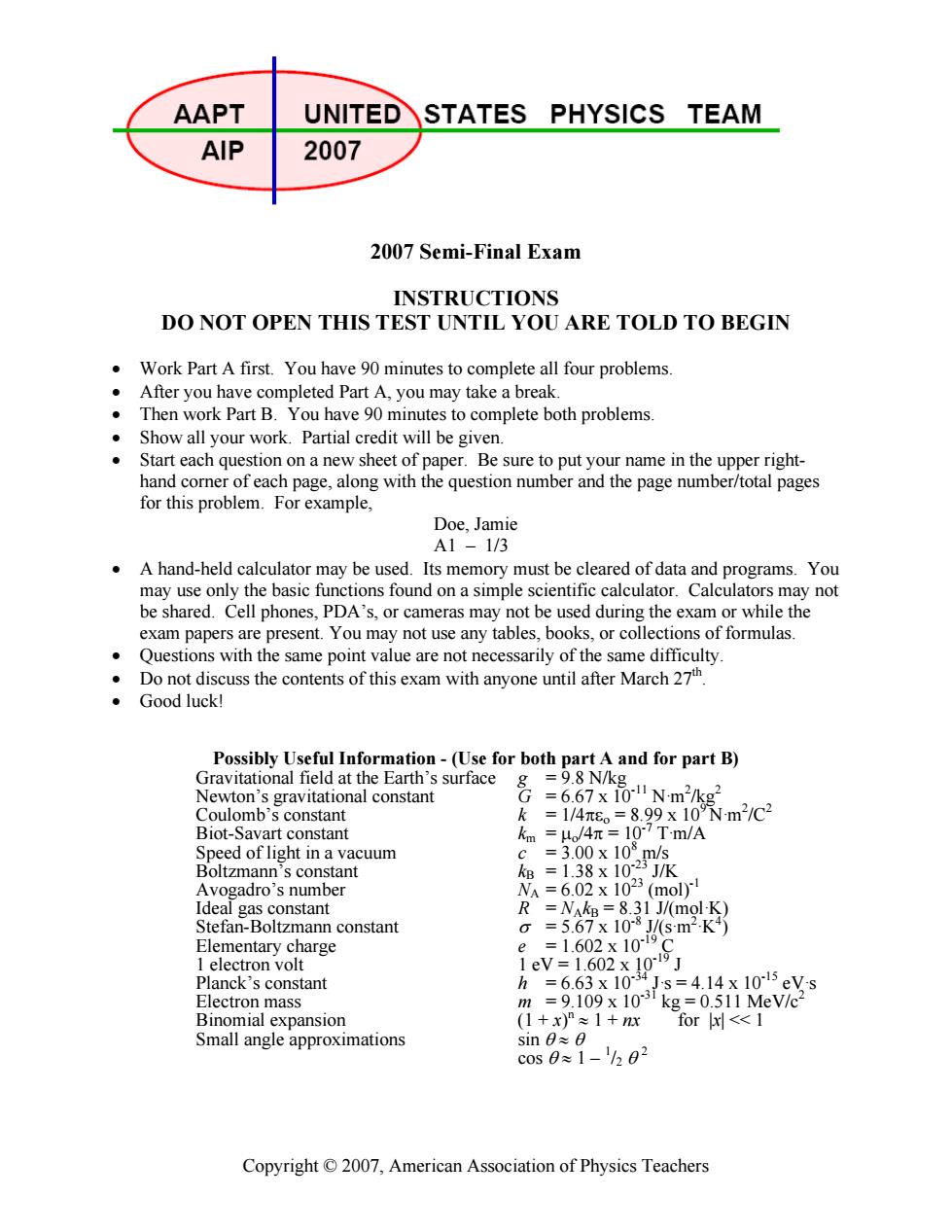正在加载图片...

AAPT UNITEDSTATES PHYSICS TEAM AIP 2007 2007 Semi-Final Exam INSTRUCTIONS DO NOT OPEN THIS TEST UNTIL YOU ARE TOLD TO BEGIN Work Part A first.You have 90 minutes to complete all four problems. After you have completed Part A,you may take a break. Then work Part B.You have 90 minutes to complete both problems. Show all your work.Partial credit will be given. Start each question on a new sheet of paper.Be sure to put your name in the upper right- hand corner of each page,along with the question number and the page number/total pages for this problem.For example, Doe,Jamie A1-1/3 A hand-held calculator may be used.Its memory must be cleared of data and programs.You may use only the basic functions found on a simple scientific calculator.Calculators may not be shared.Cell phones,PDA's,or cameras may not be used during the exam or while the exam papers are present.You may not use any tables,books,or collections of formulas. Questions with the same point value are not necessarily of the same difficulty. .Do not discuss the contents of this exam with anyone until after March 27th Good luck! Possibly Useful Information-(Use for both part A and for part B) Gravitational field at the Earth's surface g =9.8 N/kg Newton's gravitational constant =6.67xi0-11Nm2kg2 Coulomb's constant k =1/4π8。=8.99x10Nm21c2 Biot-Savart constant Km =μo/4π=10~7Tm/A Speed of light in a vacuum =3.00x108m/s Boltzmann's constant 阳=1.38x102J/K Avogadro's number N=6.02x1023(mo Ideal gas constant R =NAkB =8.31 J/(mol-K) Stefan-Boltzmann constant o=5.67x108J/(sm2K4 Elementary charge e=1.602x1019C 1 electron volt 1eV=1.602x1019J Planck's constant h =6.63x1034Js=4.14x10-15eVs Electron mass m =9.109 x 103T kg=0.511 MeV/e2 Binomial expansion (1+x)P≈1+x forx<1 Small angle approximations sin0≈0 cos0≈1-'202 Copyright 2007,American Association of Physics Teachers2007 Semi-Final Exam INSTRUCTIONS DO NOT OPEN THIS TEST UNTIL YOU ARE TOLD TO BEGIN • Work Part A first. You have 90 minutes to complete all four problems. • After you have completed Part A, you may take a break. • Then work Part B. You have 90 minutes to complete both problems. • Show all your work. Partial credit will be given. • Start each question on a new sheet of paper. Be sure to put your name in the upper righthand corner of each page, along with the question number and the page number/total pages for this problem. For example, Doe, Jamie A1 – 1/3 • A hand-held calculator may be used. Its memory must be cleared of data and programs. You may use only the basic functions found on a simple scientific calculator. Calculators may not be shared. Cell phones, PDA’s, or cameras may not be used during the exam or while the exam papers are present. You may not use any tables, books, or collections of formulas. • Questions with the same point value are not necessarily of the same difficulty. • Do not discuss the contents of this exam with anyone until after March 27th. • Good luck! Possibly Useful Information - (Use for both part A and for part B) Gravitational field at the Earth’s surface g = 9.8 N/kg Newton’s gravitational constant G = 6.67 x 10-11 N·m 2 /kg2 Coulomb’s constant k = 1/4πεο = 8.99 x 109 N·m2 /C2 Biot-Savart constant km = µο/4π = 10-7 T·m/A Speed of light in a vacuum c = 3.00 x 108 m/s Boltzmann’s constant kB = 1.38 x 10-23 J/K Avogadro’s number NA = 6.02 x 1023 (mol)-1 Ideal gas constant R = NAkB = 8.31 J/(mol·K) Stefan-Boltzmann constant σ = 5.67 x 10-8 J/(s·m2 ·K4 ) Elementary charge e = 1.602 x 10-19 C 1 electron volt 1 eV = 1.602 x 10-19 J Planck’s constant h = 6.63 x 10-34 J·s = 4.14 x 10-15 eV·s Electron mass m = 9.109 x 10-31 kg = 0.511 MeV/c2 Binomial expansion (1 + x) n ≈ 1 + nx for |x| << 1 Small angle approximations sin θ ≈ θ cos θ ≈ 1 – 1 /2 θ 2 Copyright © 2007, American Association of Physics Teachers